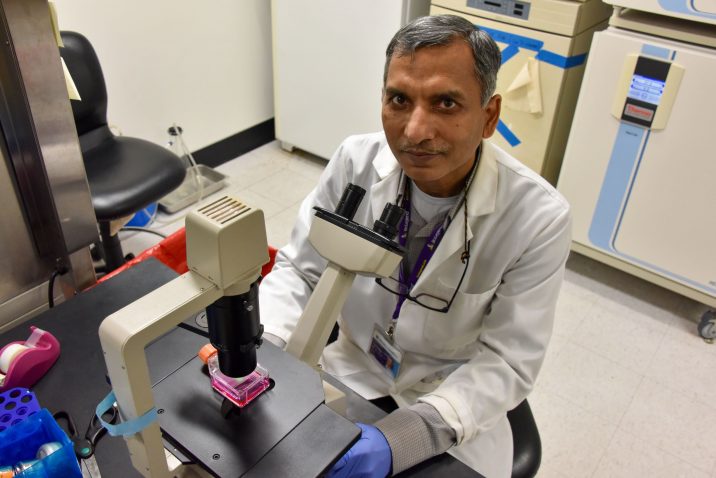To build better vaccines, scientists want to know more about how our bodies make adequate numbers of effective, durable antibodies against the influenza virus.
They are looking at a key pathway in how immune cells, called B cells, see the virus, then become the plasma cells that make the antibodies that can destroy it, or at least keep it from infecting us.
This ufmylation pathway is known to modify proteins and so cell function, and immunologist Dr. Nagendra Singh has evidence that it is key to our essential production of antibodies.
A $2.25 million grant (1RO1AI155774-01) from the National Institute of Allergy and Infectious Diseases is helping Singh, associate professor in the Department of Biochemistry and Molecular Biology at the Medical College of Georgia at Augusta University, further explore these molecular mechanisms behind protective plasma cells and the longevity of the influenza-specific antibodies they make.
His longer-term goals include designing small molecules, drugs and/or using gene-editing technology like CRISPR-Cas9, to shore up problems that result in a less than optimal immune response. Selective upward adjustment of ufmylation in key cells could mean more effective vaccines, while turning it down might help allergy sufferers and individuals with autoimmune disease resulting from an over-aggressive immune response, he notes.
Our normal antibody production looks something like this: B cells develop from stem cells in the bone marrow, then migrate to the spleen and other lymphoid tissue, like the lymph nodes, and circulate in the blood, keeping an eye out for pathogens like the influenza virus or novel coronavirus.
When the influenza virus Singh is studying gains access to us, typically via the nose after an infected person nearby sneezes or coughs, part of the virus will reach our lymphoid organs. There, through a process called VDJ recombination, B cells have the ability to rapidly recognize and develop receptors that enable them to respond to more than 10 billion different antigens. When the invader binds to the specific receptor B cells made, it sets in motion the B cell becoming a plasma cell that produces an antibody that targets that virus. It’s usual for several different B cells to each make different plasma cells that each produce a unique antibody in response to a single virus, Singh says.
Once plasma cells emerge, they go back to the bone marrow and take aim with their antibodies, which Singh likens to long-range missiles. A single plasma cell can make about 10,000 of these missiles per second that also end up in the blood, which carries them throughout the body. If all goes well, we may never know we were attacked.
Vaccines for the seasonal flu as well as new coronavirus vaccines, work different ways to essentially trick B cells into thinking they have seen a specific pathogen, which initiates the same process.
In this complex production, ubiquitin-fold modifier, or Ufm1, is a polypeptide that targets proteins through the ufmylation process and modifies their function. Ufm1 attaches to the protein Ufbp1, which Singh’s lab has shown has a novel role in enabling B cells to become plasma cells and in plasma cells stepping up antibody production.
Inside plasma cells, Ufbp1 gets upregulated to enable expansion of the endoplasmic reticulum, a membranous network inside cells that in the case of plasma cells functions like a manufacturing plant for antibodies. Singh’s lab has shown that bigger is better in this case since smaller plants produce fewer antibodies. He also has shown that the endoplasmic reticulum gets smaller when even one of the ufmylation pathway components is missing.
Now Singh and his team are deleting the components of ufmylation from B cells in mice and also expressing a mutant form of Ufbp1 in the lab animals. Mice are then infected with the influenza virus, and monitored for development of plasma cells and the neutralizing antibodies that target the virus.
“We want to see how it effects how many influenza-specific plasma cells develop in these mice who do not have Ufbp1 or Ufm1 or the other components of the ufmylation pathway in B cells,” Singh says. They expect, and have some evidence, they’ll see far fewer plasma cells against influenza without some or all these key components, but want to ensure they are correct about ufmylation’s key role.
They also are infecting mice with the influenza virus and, once plasma cells develop in response and the antibodies they produce occur, deleting the ufmylation components from the plasma cells, then watching how long the influenza-specific plasma cells and antibodies survive.
They also are looking again at what happens to the size of the endoplasmic reticulum where the antibodies are made, and how many antibodies get made. Again, they have some evidence, but need more, that when even a single component of the ufmylation pathway is missing, the antibody production site will be smaller and so will antibody production.
“Plasma cells have only one job in the body: To make antibodies,” Singh says. If they can learn more about how long these cells survive, they can design those small molecules, drugs or other methods to maximize their longevity and their antibody production.
He notes huge individual variability in how long antibodies to a virus or bacterium live and how many we have. Exposure to the novel coronavirus, for example, has produced antibodies in some individuals that last a few weeks and in others that last several months. Established vaccines also produce a wide range of timeframes for effectiveness, from the measles vaccine, for example, which is considered to afford lifelong protection while protection from pertussis, or whooping cough, and pneumonia are expected to last five to 10 years. The influenza vaccine is recommended yearly, both because the prevalent strains of virus vary from year to year and because the plasma cells the virus inspires also only live about one year, Singh says. The half-life of these antibodies is a few weeks, so antibody levels will drop soon after plasma cells expire. The hope is to enable all vaccines to have long-term effectiveness, he says.
Singh doesn’t yet know if individual variations in the ufmylation pathway also help explain the wide range of responses — from asymptomatic to death — different people experience from infection by the influenza virus as well as what is being seen with the coronavirus, but it must be a factor, he says.
“We do not know yet if there is a difference in your ufmylation pathway that dictates how much antibody you are making against, say the coronavirus, or how long those antibodies live in your body,” Singh adds. Looking at ufmylation components in B cells and plasma cells should eventually help provide insight, he adds.
Singh published in 2019 in the journal Nature Communications that Ufbp1 suppresses the enzyme PERK to help B cells differentiate into plasma cells. PERK helps correct problems with improperly folded proteins (proteins have to be folded correctly to function correctly) but PERK also stops new protein production in the process, so Ufbp1 stops it to enable ample protein folding and plasma cell production.
 Augusta University
Augusta University




